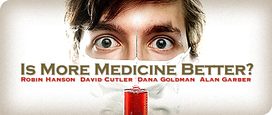I said I’m “all for finding better ways to favor helpful over harmful medicine” but I asked “why must this distant possibility stop us from publicizing and acting now on our consensus that we expect little net health harm from crude cuts?” and I suggested six possible reasons one might offer.
Dana Goldman pointed to one of those reasons, specific identifiable beneficial treatments, and he and I are now discussing that line of reasoning. Alan Garber seems to endorse at least one large crude cut:
Capping or eliminating the tax exclusion for health insurance would be one way to increase the effective price of insurance, and it would undoubtedly diminish the incentives to consume too much care.
Alan notes that such policies seem politically unrealistic now, a point I grant. My goal here has been to get health policy folks to publicly admit that their data suggests little net health harm from crude cuts.
David Cutler responded with an analogy to data on happiness and GDP. He asks: if studies suggest aggregate variations in happiness seem unrelated to aggregate variations in GDP,
can one conclude that cutting income in the United States by 30 percent across the board would leave Americans unaffected? Of course, this is folly. … Sweden makes up for lower average incomes with a more equal income distribution and with the provision of more social goods. The net effect on happiness is a wash.
David, in this case you seem to be suggesting that aggregate happiness studies are missing adequate controls, i.e., you suggest that happiness studies which controlled for income equality and social goods would in fact show that aggregate variations in GDP are substantially related to aggregate variations in happiness. This is exactly the kind of specific critique that I request for aggregate studies on medicine and health. Please, why, specifically, are such studies misleading? For example, what particular controls are missing?

